LLO
-
 Artificial Spore Production Technology Developed
The core technology needed in the development of ‘biosensors’ so crucial in diagnosing illnesses or pathogens was developed by Korean research team.
KAIST’s Professor Choi In Seung of the department of Chemistry developed the technology that allows for the production of Artificial Spore by selectively coating a live cell.
In the field of engineering the problem in developing the next generation bio sensor, the cell based sensor, was that it was difficult to keep a cell alive without division for a long time. Once a cell is taken out of the body, it will either divide or die easily.
Professor Choi’s research team mimicked the spore, which has the capability to survive harsh conditions without division, and chemically coated a live cell and artificially created a cell similar to that of a spore.
The physical and biological stabilities of the cell increased by coating an artificial shell over the yeast cell. The shell is composed with a protein similar to that of the protein that gives mussels its stickiness. In addition by controlling the thickness of the shell, the division rate of the yeast can be controlled.
Professor Choi commented that this technology will serve as the basis for the single cell based biosensor.
The research was conducted together with Professor Lee Hae Shin of KAIST department of Chemistry and Professor Jeong Taek Dong of Seoul National University’s department of Chemistry and was published as the cover paper of ‘Journal of the American Chemical Society’.
2011.04.01 View 14837
Artificial Spore Production Technology Developed
The core technology needed in the development of ‘biosensors’ so crucial in diagnosing illnesses or pathogens was developed by Korean research team.
KAIST’s Professor Choi In Seung of the department of Chemistry developed the technology that allows for the production of Artificial Spore by selectively coating a live cell.
In the field of engineering the problem in developing the next generation bio sensor, the cell based sensor, was that it was difficult to keep a cell alive without division for a long time. Once a cell is taken out of the body, it will either divide or die easily.
Professor Choi’s research team mimicked the spore, which has the capability to survive harsh conditions without division, and chemically coated a live cell and artificially created a cell similar to that of a spore.
The physical and biological stabilities of the cell increased by coating an artificial shell over the yeast cell. The shell is composed with a protein similar to that of the protein that gives mussels its stickiness. In addition by controlling the thickness of the shell, the division rate of the yeast can be controlled.
Professor Choi commented that this technology will serve as the basis for the single cell based biosensor.
The research was conducted together with Professor Lee Hae Shin of KAIST department of Chemistry and Professor Jeong Taek Dong of Seoul National University’s department of Chemistry and was published as the cover paper of ‘Journal of the American Chemical Society’.
2011.04.01 View 14837 -
 Professor Bae of Industrial Design Wins Good Design Award.
Professor Bae Sang Min’s research team of the Industrial Design Department received a G-Mark on the Product Design Section from the Good Design Awards 2010 organized by the Japan Industrial Design Promotion Organization through the exhibition of a Green Sharing Project, Heartea.
Heartea is a tumbler that allows the user to easily know the temperature of the liquid contained inside. Heartea is a name that combines Heart and Tea to refer to a tumbler that contains heart-warming tea.
Heartea was designed and produced by Professor Bae’s research team and was funded by GS Caltex. World Vision selected charity targets and oversaw distribution, and all of the sales income (about 200 million won) was donated as a scholarship to teenagers with financial difficulties.
The project has begun in 2006, and its accumulative sales are 1.7 billion won. Twenty million won is donated to 147 teenagers every year as scholarship, and through annual sharing camp, social leaders mentor teenagers to help them achieve their dreams.
The Good Design Award organized annually by Japan Industrial Design Promotion Organization has a fifty year tradition and is one of the world’s top four design contests with 6,000 submissions from 50 different countries participated.
Professor Bae’s team has won three of the top four design contests including the German Red Dot Product Award and the American IDEA Product Award.
Along with Heartea, both of foldable MP3 in 2008 and natural humidifier Lovepot in 2009 won an award from these four contests.
“Through continuous research, I hope to create the world’s best philanthropy design research center to help Third World countries and the neglected. I want to participate in creating a better world through design,” said Professor Bae.
2010.11.05 View 13906
Professor Bae of Industrial Design Wins Good Design Award.
Professor Bae Sang Min’s research team of the Industrial Design Department received a G-Mark on the Product Design Section from the Good Design Awards 2010 organized by the Japan Industrial Design Promotion Organization through the exhibition of a Green Sharing Project, Heartea.
Heartea is a tumbler that allows the user to easily know the temperature of the liquid contained inside. Heartea is a name that combines Heart and Tea to refer to a tumbler that contains heart-warming tea.
Heartea was designed and produced by Professor Bae’s research team and was funded by GS Caltex. World Vision selected charity targets and oversaw distribution, and all of the sales income (about 200 million won) was donated as a scholarship to teenagers with financial difficulties.
The project has begun in 2006, and its accumulative sales are 1.7 billion won. Twenty million won is donated to 147 teenagers every year as scholarship, and through annual sharing camp, social leaders mentor teenagers to help them achieve their dreams.
The Good Design Award organized annually by Japan Industrial Design Promotion Organization has a fifty year tradition and is one of the world’s top four design contests with 6,000 submissions from 50 different countries participated.
Professor Bae’s team has won three of the top four design contests including the German Red Dot Product Award and the American IDEA Product Award.
Along with Heartea, both of foldable MP3 in 2008 and natural humidifier Lovepot in 2009 won an award from these four contests.
“Through continuous research, I hope to create the world’s best philanthropy design research center to help Third World countries and the neglected. I want to participate in creating a better world through design,” said Professor Bae.
2010.11.05 View 13906 -
 Yoon-Gyeong Shim donates two billion won's worth of stocks to KAIST.
“We hope KAIST will succeed my late husband’s will.”
A 47-year-old widow donated two billion won’s worth of stock to KAIST in respect to her late husband’s will for the scientific development and training of scientifically talented people of Korea.
On the 27 of September, KAIST announced that the late CEO of Seoul Alloy Metal’s widow, Yoon-Gyeong Shim, donated her and her children’s inheritance of two billion won’s worth of stocks to KAIST through an agent.
While wondering how to spend their inherited two billion won, the family found certificates and contracts of donation in the late CEO Geyong-Dae Kim’s possession. The late lamented Mr. Kim had been donating a certain amount of money monthly for those in need, including undernourished children.
Shim decided to donate to Korea’s IT-leading KAIST to succeed her late husband’s will, the husband who lived a life of sharing and dedicated his whole life in the IT department. Shim’s two children, Hyunjae (19 years old) and Youngjae (17 years old) happily participated in this decision.
The company represented by Kim, Seoul Alloy Metals, is a national company that produces basic conjugates used in electric and electronic machinery, with founding technology in the environmental-friendly smokeless lead-free solder division.
“I believe my late husband, who passed away before his time, would be glad with our family’s decision,” said Shim. “We may be living in a faraway country called New Zealand but my children and I are proud Koreans and we are very glad to give a small hand to Korea’s proud KAIST. We hope KAIST can succeed my late husband’s passion and will for the development of scientific technology. We wish it can be used not only for the development of KAIST, but for the development of Korea.”
“KAIST is grateful of Shim’s decision to donate to KAIST,” said President Suh. “To follow the lofty will of the decedent, KAIST will try our best to train the best scientifically talented people and become the best university in the world.”
Since appointment of President Suh at KAIST, KAIST has put an effort to spread a donating culture. As a result, KAIST donators have expanded omnidirectionally, including professors, staff, students, alumni, parents of students, and the general public.
The number of donations was 1,004 in 2006, 2,139 in 2007, 3,066 in 2008, and 3,304 in 2009.
2010.09.29 View 10006
Yoon-Gyeong Shim donates two billion won's worth of stocks to KAIST.
“We hope KAIST will succeed my late husband’s will.”
A 47-year-old widow donated two billion won’s worth of stock to KAIST in respect to her late husband’s will for the scientific development and training of scientifically talented people of Korea.
On the 27 of September, KAIST announced that the late CEO of Seoul Alloy Metal’s widow, Yoon-Gyeong Shim, donated her and her children’s inheritance of two billion won’s worth of stocks to KAIST through an agent.
While wondering how to spend their inherited two billion won, the family found certificates and contracts of donation in the late CEO Geyong-Dae Kim’s possession. The late lamented Mr. Kim had been donating a certain amount of money monthly for those in need, including undernourished children.
Shim decided to donate to Korea’s IT-leading KAIST to succeed her late husband’s will, the husband who lived a life of sharing and dedicated his whole life in the IT department. Shim’s two children, Hyunjae (19 years old) and Youngjae (17 years old) happily participated in this decision.
The company represented by Kim, Seoul Alloy Metals, is a national company that produces basic conjugates used in electric and electronic machinery, with founding technology in the environmental-friendly smokeless lead-free solder division.
“I believe my late husband, who passed away before his time, would be glad with our family’s decision,” said Shim. “We may be living in a faraway country called New Zealand but my children and I are proud Koreans and we are very glad to give a small hand to Korea’s proud KAIST. We hope KAIST can succeed my late husband’s passion and will for the development of scientific technology. We wish it can be used not only for the development of KAIST, but for the development of Korea.”
“KAIST is grateful of Shim’s decision to donate to KAIST,” said President Suh. “To follow the lofty will of the decedent, KAIST will try our best to train the best scientifically talented people and become the best university in the world.”
Since appointment of President Suh at KAIST, KAIST has put an effort to spread a donating culture. As a result, KAIST donators have expanded omnidirectionally, including professors, staff, students, alumni, parents of students, and the general public.
The number of donations was 1,004 in 2006, 2,139 in 2007, 3,066 in 2008, and 3,304 in 2009.
2010.09.29 View 10006 -
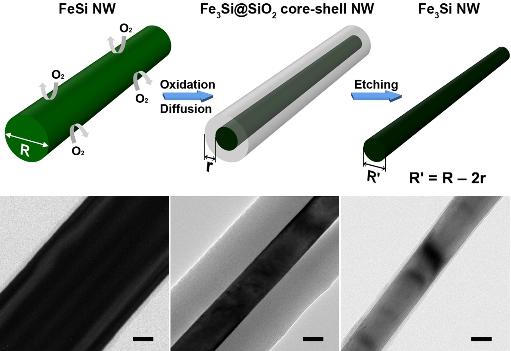 Nanowire crystal transformation method was newly developed by a KAIST research team.
Figure 1
Schematic illustration of NW crystal transformation process. FeSi is converted to Fe3Si by high-temperature thermal annealing in diluted O2 condition and subsequent wet etching by 5% HF.
Figure 2
Low-resolution TEM images of FeSi; Fe3Si@SiO2 core—shell; Fe3Si NW after shell-etching; and Scale bars are 20 nm
Professor Bongsoo Kim of the Department of Chemistry, KAIST, and his research team succeeded to fabricate Heusler alloy Fe3Si nanowires by a diffusion-driven crystal structure transformation method from paramagnetic FeSi nanowires. This methodology is also applied to Co2Si nanowires in order to obtain metal-rich nanowires (Co) as another evidence of the structural transformation process. The newly developed nanowire crystal transformation method, Professor Kim said, would be valuable as a general method to fabricate metal-rich silicide nanowires that are otherwise difficult to synthesize.
Metal silicide nanowires are potentially useful in a wide array of fields including nao-optics, information technology, biosensors, and medicine. Chemical synthesis of these nanowires, however, is challenging due to the complex phase behavior of silicides.
The metal silicide nanowires are grown on a silicon substrate covered with a thin layer of silicon oxide via a simple chemical vapor deposition (CVD) process using single or multiple source precursors. Alternatively, the nanowires can be grown on the thin silicon oxide film via a chemical vapor transport (CVT) process using solid metal silicide precursors.
The CVT-based method has been highly effective for the syntheses of metal silicide NWs, but changing the composition of metal silicide NWs in a wider range, especially achieving a composition of a metal to silicon, has been quite difficult.
Thus, developing efficient and reliable synthetic methods to adjust flexibly the elemental compositions in metal silicide NWs can be valuable for the fabrication of practical spintronic and neonelectronic devices.
Professor Kim expliained, “The key concept underlying this work is metal-enrichment of metal silicide NWs by thermal diffusion. This conversion method could prove highly valuable, since novel metal-rich silicide NWs that are difficult to synthesize but possess interesting physical properties can be fabricated from other metal silicide NWs.”
The research result was published in Nanao Letters, a leading peer-reviewed journal, and posted online in early August 2010.
2010.08.25 View 12992
Nanowire crystal transformation method was newly developed by a KAIST research team.
Figure 1
Schematic illustration of NW crystal transformation process. FeSi is converted to Fe3Si by high-temperature thermal annealing in diluted O2 condition and subsequent wet etching by 5% HF.
Figure 2
Low-resolution TEM images of FeSi; Fe3Si@SiO2 core—shell; Fe3Si NW after shell-etching; and Scale bars are 20 nm
Professor Bongsoo Kim of the Department of Chemistry, KAIST, and his research team succeeded to fabricate Heusler alloy Fe3Si nanowires by a diffusion-driven crystal structure transformation method from paramagnetic FeSi nanowires. This methodology is also applied to Co2Si nanowires in order to obtain metal-rich nanowires (Co) as another evidence of the structural transformation process. The newly developed nanowire crystal transformation method, Professor Kim said, would be valuable as a general method to fabricate metal-rich silicide nanowires that are otherwise difficult to synthesize.
Metal silicide nanowires are potentially useful in a wide array of fields including nao-optics, information technology, biosensors, and medicine. Chemical synthesis of these nanowires, however, is challenging due to the complex phase behavior of silicides.
The metal silicide nanowires are grown on a silicon substrate covered with a thin layer of silicon oxide via a simple chemical vapor deposition (CVD) process using single or multiple source precursors. Alternatively, the nanowires can be grown on the thin silicon oxide film via a chemical vapor transport (CVT) process using solid metal silicide precursors.
The CVT-based method has been highly effective for the syntheses of metal silicide NWs, but changing the composition of metal silicide NWs in a wider range, especially achieving a composition of a metal to silicon, has been quite difficult.
Thus, developing efficient and reliable synthetic methods to adjust flexibly the elemental compositions in metal silicide NWs can be valuable for the fabrication of practical spintronic and neonelectronic devices.
Professor Kim expliained, “The key concept underlying this work is metal-enrichment of metal silicide NWs by thermal diffusion. This conversion method could prove highly valuable, since novel metal-rich silicide NWs that are difficult to synthesize but possess interesting physical properties can be fabricated from other metal silicide NWs.”
The research result was published in Nanao Letters, a leading peer-reviewed journal, and posted online in early August 2010.
2010.08.25 View 12992 -
 Interesting research results were published on the use of Twitter.
The number of “followers” on your Twitter account does not necessarily mean that “Your opinions matter much” to other people.
A KAIST graduate researcher, Mi-Young Cha, joined an interesting project that studies the influence of a popular social media, Twitter. Most of Twitter users today consider the number of followers as a measurement of their influence on the social sphere. According to the research paper, however, this connection does not seem to standing together. For details, please click the link below for an article published by the New York Times.
Dr. Cha received all of her post secondary education degrees in Computer Science, including her Ph.D. in 2008, from KAIST. Since 2008 till now, she has been a post doctoral researcher at Max Planck Institute for Software Systems (MPI-SWS) based in Germany.
[New York Times Article, March 19, 2010]
http://www.nytimes.com/external/readwriteweb/2010/03/19/19readwriteweb-the-million-follower-fallacy-audience-size-d-3203.html
2010.04.05 View 15522
Interesting research results were published on the use of Twitter.
The number of “followers” on your Twitter account does not necessarily mean that “Your opinions matter much” to other people.
A KAIST graduate researcher, Mi-Young Cha, joined an interesting project that studies the influence of a popular social media, Twitter. Most of Twitter users today consider the number of followers as a measurement of their influence on the social sphere. According to the research paper, however, this connection does not seem to standing together. For details, please click the link below for an article published by the New York Times.
Dr. Cha received all of her post secondary education degrees in Computer Science, including her Ph.D. in 2008, from KAIST. Since 2008 till now, she has been a post doctoral researcher at Max Planck Institute for Software Systems (MPI-SWS) based in Germany.
[New York Times Article, March 19, 2010]
http://www.nytimes.com/external/readwriteweb/2010/03/19/19readwriteweb-the-million-follower-fallacy-audience-size-d-3203.html
2010.04.05 View 15522 -
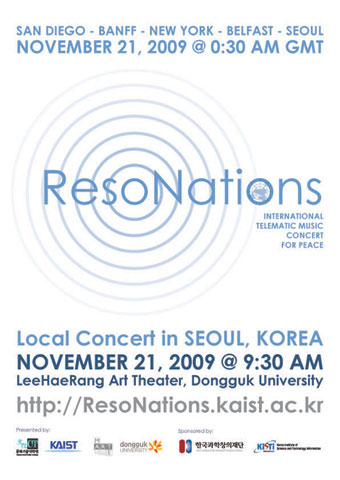 Int'l Telematic Music Concert for Peace to Take Place on Nov. 20
Renowned musicians in five international locations perform new contemporary music works for peace through a real-time performance on the internet. Local audiences in Seoul, Banff, New York, San Diego and Belfast will also have a chance to hear a program.
In Seoul, the "International Telematic Music Concert for Peace" will be held at the LeeHaeRang Art Theater, Dongguk University, in Seoul on Nov. 20 at 9:30 a.m., under the presentation of KAIST"s Graduate School of Culture Technology and MARTE Lab, Dongguk University. Telematic music is real-time performance via the internet by musicians in different geographic locations.
The program of the concert includes "Hope"s Dream" by Mark Dresser and Sarah Weaver; "Disparate Bodies" by Pedro Rebelo, "Rock, Paper, Scissors" by Chris Chafe. The Korean act to be performed is "Green-colored Harmony" by Jun Kim.
In addition to the two Korean universities, the World Association of Former United Nations Internes and Fellows (WAFUNIF), University of California San Diego, the Banff Center of Canada and Queen"s University in Belfast are participating in the project.
The performance will take place on high-bandwidth internet with JackTrip audio software developed by Chris Chafe and Access Grid video software developed at Argonne National Laboratory.
"Connecting the five different cities together through super-speed Internet network and transmitting sound and images in real time is challenging technically. But, we also expect that more exciting results will be created in the course of transforming the sound into visual images," said Woon-Seung Yeo, a professor of the Graduate School of Culture Technology, who was responsible for visuals in the project.
2009.11.19 View 15925
Int'l Telematic Music Concert for Peace to Take Place on Nov. 20
Renowned musicians in five international locations perform new contemporary music works for peace through a real-time performance on the internet. Local audiences in Seoul, Banff, New York, San Diego and Belfast will also have a chance to hear a program.
In Seoul, the "International Telematic Music Concert for Peace" will be held at the LeeHaeRang Art Theater, Dongguk University, in Seoul on Nov. 20 at 9:30 a.m., under the presentation of KAIST"s Graduate School of Culture Technology and MARTE Lab, Dongguk University. Telematic music is real-time performance via the internet by musicians in different geographic locations.
The program of the concert includes "Hope"s Dream" by Mark Dresser and Sarah Weaver; "Disparate Bodies" by Pedro Rebelo, "Rock, Paper, Scissors" by Chris Chafe. The Korean act to be performed is "Green-colored Harmony" by Jun Kim.
In addition to the two Korean universities, the World Association of Former United Nations Internes and Fellows (WAFUNIF), University of California San Diego, the Banff Center of Canada and Queen"s University in Belfast are participating in the project.
The performance will take place on high-bandwidth internet with JackTrip audio software developed by Chris Chafe and Access Grid video software developed at Argonne National Laboratory.
"Connecting the five different cities together through super-speed Internet network and transmitting sound and images in real time is challenging technically. But, we also expect that more exciting results will be created in the course of transforming the sound into visual images," said Woon-Seung Yeo, a professor of the Graduate School of Culture Technology, who was responsible for visuals in the project.
2009.11.19 View 15925 -
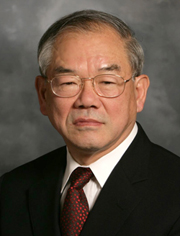 President Suh Speaks on Innovation in Asia at Glion Colloquium
KAIST President Nam-Pyo Suh stressed the importance of innovation in economic advancement in an address he delivered at the Glion Colloquium held in Glion, Switzerland, university authorities said on Wednesday (June 24).
In the speech, entitled "On Innovation Strategies: An Asian Perspective," President Suh said that for Asian countries such as China, Japan, Korea and Taiwan to continue to compete in the global economy, they must become innovators.
Over the past decade the Glion Colloquium organized by the University of Geneva has established itself as an influential international forum on higher education issues, related to research intensive universities in particular.
When it was launched in 1998, the Glion Colloquium immediately drew worldwide attention with “The Glion Declaration: the University at the Millennium,” prepared for the 1998 Paris UNESCO World Conference on Higher Education in the 21st Century.
Every two years, the colloquium brings together in Glion, Switzerland, leaders from renowned universities and higher education organizations, along with influential business and government figures, from North America, Europe and other parts of the world.
2009.06.25 View 11961
President Suh Speaks on Innovation in Asia at Glion Colloquium
KAIST President Nam-Pyo Suh stressed the importance of innovation in economic advancement in an address he delivered at the Glion Colloquium held in Glion, Switzerland, university authorities said on Wednesday (June 24).
In the speech, entitled "On Innovation Strategies: An Asian Perspective," President Suh said that for Asian countries such as China, Japan, Korea and Taiwan to continue to compete in the global economy, they must become innovators.
Over the past decade the Glion Colloquium organized by the University of Geneva has established itself as an influential international forum on higher education issues, related to research intensive universities in particular.
When it was launched in 1998, the Glion Colloquium immediately drew worldwide attention with “The Glion Declaration: the University at the Millennium,” prepared for the 1998 Paris UNESCO World Conference on Higher Education in the 21st Century.
Every two years, the colloquium brings together in Glion, Switzerland, leaders from renowned universities and higher education organizations, along with influential business and government figures, from North America, Europe and other parts of the world.
2009.06.25 View 11961 -
 Prof. Cho Wins Best Paper Award
KAIST Prof. Nam-Zin Cho of the Department of Nuclear and Quantum Engineering, won the Best Thesis Award in the nuclear reactor physics category at the 2008 Winter Meeting of the American Nuclear Society held on Nov. 9-13 in Reno, Nevada.
His paper, entitled "Thermal Feedback Transient Analysis of a Pebble Fuel Based on the Two-Temperature Homogenized Model," was jointly authored by Hwi Yu and Jong-Un Kim under the guidance of Prof. Cho.
Prof. Cho was elected a fellow of the American Nuclear Society in 2001 and has served as the deputy editor of the Nuclear Science and Engineering, the research journal of the American Nuclear Society, since 1999.
2008.12.09 View 16800
Prof. Cho Wins Best Paper Award
KAIST Prof. Nam-Zin Cho of the Department of Nuclear and Quantum Engineering, won the Best Thesis Award in the nuclear reactor physics category at the 2008 Winter Meeting of the American Nuclear Society held on Nov. 9-13 in Reno, Nevada.
His paper, entitled "Thermal Feedback Transient Analysis of a Pebble Fuel Based on the Two-Temperature Homogenized Model," was jointly authored by Hwi Yu and Jong-Un Kim under the guidance of Prof. Cho.
Prof. Cho was elected a fellow of the American Nuclear Society in 2001 and has served as the deputy editor of the Nuclear Science and Engineering, the research journal of the American Nuclear Society, since 1999.
2008.12.09 View 16800 -
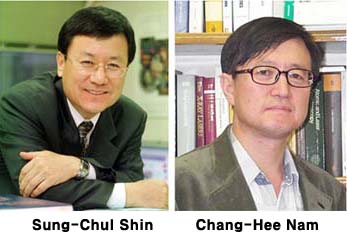 Two KAIST Professors Elected Fellows of APS
Profs. Sung-Chul Shin and Chang-Hee Nam of the Department of Physics, KAIST, have recently been elected the 2009 fellows of the American Physical Society (APS), university officials said on Tuesday (Dec. 2).
The APS fellowship is a prestigious recognition of the two professors" outstanding academic achievements in the field of physics, the officials said. The selection criteria are known to be extremely stringent and only a small fraction of APS members become fellows.
Prof. Shin was cited for his pioneering contributions to the understanding of magnetization reversal dynamics, in particular critical scaling behavior of Barkhausen avalanches of 2D ferromagnets, and discovery of novel magnetic thin films and multilayers for high-density data storage.
Prof. Nam was recognized for his contributions to the theory and experiments of physical processes of high harmonic generation for the development of attosecond coherent x-ray sources and related femtosecond laser technology.
The American Physical Society, founded in 1899, is the world"s second largest organization of physicists, behind the Deutsche Physikalische Gesellschaft. It has 46,000 members across the world.
2008.12.04 View 16566
Two KAIST Professors Elected Fellows of APS
Profs. Sung-Chul Shin and Chang-Hee Nam of the Department of Physics, KAIST, have recently been elected the 2009 fellows of the American Physical Society (APS), university officials said on Tuesday (Dec. 2).
The APS fellowship is a prestigious recognition of the two professors" outstanding academic achievements in the field of physics, the officials said. The selection criteria are known to be extremely stringent and only a small fraction of APS members become fellows.
Prof. Shin was cited for his pioneering contributions to the understanding of magnetization reversal dynamics, in particular critical scaling behavior of Barkhausen avalanches of 2D ferromagnets, and discovery of novel magnetic thin films and multilayers for high-density data storage.
Prof. Nam was recognized for his contributions to the theory and experiments of physical processes of high harmonic generation for the development of attosecond coherent x-ray sources and related femtosecond laser technology.
The American Physical Society, founded in 1899, is the world"s second largest organization of physicists, behind the Deutsche Physikalische Gesellschaft. It has 46,000 members across the world.
2008.12.04 View 16566 -
 KAIST Team Identifies Nano-scale Origin of Toughness in Rare Earth-added Silicon Carbide
A research team led by Prof. Do-Kyung Kim of the Department of Materials Science and Engineering of KAIST has identified the nano-scale origin of the toughness in rare-earth doped silicon carbide (RE-SiC), university sources said on Monday (Oct. 6).
The research was conducted jointly with a U.S. team headed by Prof. R. O. Ritchie of the Department of Materials Science and Engineering, University of California, Berkeley.
The findings were carried in the online edition of Nano Letters published by the American Chemical Association.
Silicon carbide, a ceramic material known to be one of the hardest substances, are potential candidate materials for many ultrahigh-temperature structural applications. For example, if SiC, instead of metallic alloys, is used in gas-turbine engines for power generation and aerospace applications, operating temperatures of many hundred degrees higher can be obtained with a consequent dramatic increase in thermodynamic efficiency and reduced fuel consumption. However, the use of such ceramic materials has so far been severely limited since the origin of the toughness in RE-SiC remained unknown thus far.
In order to investigate the origin of the toughness in RE-SiC, the researchers attempted to examine the mechanistic nature of the cracking events, which they found to occur precisely along the interface between SiC grains and the nano-scale grain-boundary phase, by using ultrahigh-resolution transmission electron microscopy and atomic-scale spectroscopy. The research found that for optimal toughness, the relative elastic modulus across the grain-boundary phase and the interfacial fracture toughness are the most critical material parameters; both can be altered with appropriate choice of rare-earth elements.
In addition to identifying the nano-scale origin of the toughness in RE-SiC, the findings also contributed to precisely predicting how the use of various rare-earth elements lead to difference in toughness.
University sources said that the findings will significantly advance the date when RE-SiC will replace metallic alloys in gas-turbine engines for power generation and aerospace applications.
2008.10.08 View 17488
KAIST Team Identifies Nano-scale Origin of Toughness in Rare Earth-added Silicon Carbide
A research team led by Prof. Do-Kyung Kim of the Department of Materials Science and Engineering of KAIST has identified the nano-scale origin of the toughness in rare-earth doped silicon carbide (RE-SiC), university sources said on Monday (Oct. 6).
The research was conducted jointly with a U.S. team headed by Prof. R. O. Ritchie of the Department of Materials Science and Engineering, University of California, Berkeley.
The findings were carried in the online edition of Nano Letters published by the American Chemical Association.
Silicon carbide, a ceramic material known to be one of the hardest substances, are potential candidate materials for many ultrahigh-temperature structural applications. For example, if SiC, instead of metallic alloys, is used in gas-turbine engines for power generation and aerospace applications, operating temperatures of many hundred degrees higher can be obtained with a consequent dramatic increase in thermodynamic efficiency and reduced fuel consumption. However, the use of such ceramic materials has so far been severely limited since the origin of the toughness in RE-SiC remained unknown thus far.
In order to investigate the origin of the toughness in RE-SiC, the researchers attempted to examine the mechanistic nature of the cracking events, which they found to occur precisely along the interface between SiC grains and the nano-scale grain-boundary phase, by using ultrahigh-resolution transmission electron microscopy and atomic-scale spectroscopy. The research found that for optimal toughness, the relative elastic modulus across the grain-boundary phase and the interfacial fracture toughness are the most critical material parameters; both can be altered with appropriate choice of rare-earth elements.
In addition to identifying the nano-scale origin of the toughness in RE-SiC, the findings also contributed to precisely predicting how the use of various rare-earth elements lead to difference in toughness.
University sources said that the findings will significantly advance the date when RE-SiC will replace metallic alloys in gas-turbine engines for power generation and aerospace applications.
2008.10.08 View 17488 -
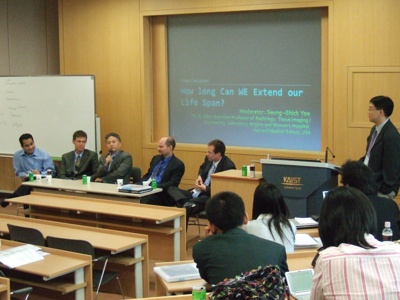 Int'l Conference for Integration of Science & Technology into Society Opens
The 2008 International Conference for the Integration of Science and Technology into Society (ICISTS-KAIST) opened a four-day meeting on Tuesday (July 15) at Daejeon KAIST campus. The conference is an annual event organized by a group of KAIST undergraduate students.
The fifth-year gathering is designed to provide participants with an opportunity to broaden their scientific perspectives by sharing ideas and experiences in related topics, as well as building an international human network. This year"s event has drawn about 200 students from 40 countries.
The centerpiece of the conference is three workshops on the following themes; Human-Robot Symbiotic Society, Neo-brain Science and Trafficmatics. Myung-Ja Kim, former Korean Environment Minister, will appear as a keynote speaker.
In the workshop sessions, two speakers will discuss specific issues and arrive at a tentative conclusion. Participants will have the opportunity to participate in the debate through Q&A for each session.
The first theme "Human-Robot Symbiotic Society" delves into the current trend that robot is being transformed into a perceivable and touchable concept from an abstract one. Guests for the workship include June-Ho Oh, professor at the Department of Mechanical Engineering, KAIST; James Dater, professor at the Department of Political Science, University of Hawaii at Manoa, and Director of the Hawaii Research Center for Future; Michael Pollitt, CEO of Shadow Robot Company; and Steven Dubowsky, professor at the Department of Mechanical Engineering, MIT.
The second theme "Neo-Brain Science" focuses on attempts to shed light on brain from diverse perspectives including psychology, economics and art. Among invited speakers are Prof. Jai-Seung Jung at the Department of Bio and Brain Engineering, KAIST; Prof. Un-Jung Kang at the University of Chicago Medical Center; and Peter Geyer, a consultant for the Association for Psychological Type.
The third workshop on "Traffimatics" will deal with "intelligent transport systems (ITS)" which will discusst new paradigm in transportation policy and traffic engineering. On the list of speakers are Assaf Biderman, assistant director, SENSEable City Laboratory, MIT; Prof. Richard Tay, at the Department of Civil Engineering, University of Calgary; Prof. Shoshi Mizokami at Kumamoto University; and Ho-Jong Baik, research associate professor of Virginia Tech.
2008.07.16 View 22530
Int'l Conference for Integration of Science & Technology into Society Opens
The 2008 International Conference for the Integration of Science and Technology into Society (ICISTS-KAIST) opened a four-day meeting on Tuesday (July 15) at Daejeon KAIST campus. The conference is an annual event organized by a group of KAIST undergraduate students.
The fifth-year gathering is designed to provide participants with an opportunity to broaden their scientific perspectives by sharing ideas and experiences in related topics, as well as building an international human network. This year"s event has drawn about 200 students from 40 countries.
The centerpiece of the conference is three workshops on the following themes; Human-Robot Symbiotic Society, Neo-brain Science and Trafficmatics. Myung-Ja Kim, former Korean Environment Minister, will appear as a keynote speaker.
In the workshop sessions, two speakers will discuss specific issues and arrive at a tentative conclusion. Participants will have the opportunity to participate in the debate through Q&A for each session.
The first theme "Human-Robot Symbiotic Society" delves into the current trend that robot is being transformed into a perceivable and touchable concept from an abstract one. Guests for the workship include June-Ho Oh, professor at the Department of Mechanical Engineering, KAIST; James Dater, professor at the Department of Political Science, University of Hawaii at Manoa, and Director of the Hawaii Research Center for Future; Michael Pollitt, CEO of Shadow Robot Company; and Steven Dubowsky, professor at the Department of Mechanical Engineering, MIT.
The second theme "Neo-Brain Science" focuses on attempts to shed light on brain from diverse perspectives including psychology, economics and art. Among invited speakers are Prof. Jai-Seung Jung at the Department of Bio and Brain Engineering, KAIST; Prof. Un-Jung Kang at the University of Chicago Medical Center; and Peter Geyer, a consultant for the Association for Psychological Type.
The third workshop on "Traffimatics" will deal with "intelligent transport systems (ITS)" which will discusst new paradigm in transportation policy and traffic engineering. On the list of speakers are Assaf Biderman, assistant director, SENSEable City Laboratory, MIT; Prof. Richard Tay, at the Department of Civil Engineering, University of Calgary; Prof. Shoshi Mizokami at Kumamoto University; and Ho-Jong Baik, research associate professor of Virginia Tech.
2008.07.16 View 22530 -
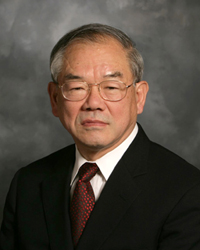 President Suh to Receive Honorary Doctorate from Carnegie Mellon University
Carnegie Mellon University of the United States has decided to present an honorary doctorate degree to KAIST President Nam-Pyo Suh, school authorities said on April 30.
President Suh will receive the honorary degree during the university"s 111th commencement ceremony at its Pittsburgh campus on May 18. Suh earned his Ph.D. in mechanical engineering at Carnegie Mellon in 1964.
Carnegie Mellon University said in a press release that Suh is honored for transforming KAIST into a world-class institution since he became president of KAIST in 2006.
"His distinguished academic career has also included posts at the University of South Carolina and the Massachusetts Institute of Technology, as well as an assistant directorship for the National Science Foundation of the United States. Beyond his academic leadership, Suh invented an industrial process for production of plastic parts that is used in factories worldwide. He holds more than 50 patents and helped start several companies," the press release said.
Five other prominent Americans will also receive honorary doctorate degrees from Carnegie Mellon along with President Suh. They are Al Gore, former U.S. vice president; Norman R. Augustine, former president and CEO of Martin-Marietta and Lockheed Martin and chairman of the American Red Cross; Jeff Bezos, founder of Amazon.com, the world"s largest online retailer; Elizabeth Catlett, an artist and sculptor famed for her dedication to the rights of minorities and women; and Patrick Colonel Suppes, a professor emeritus at Stanford University.
Carnegie Mellon, a leading research university of the United States is known for its distinctive mix of programs in engineering, computer science, robotics, business, public policy, fine arts and the humanities.
2008.04.30 View 14818
President Suh to Receive Honorary Doctorate from Carnegie Mellon University
Carnegie Mellon University of the United States has decided to present an honorary doctorate degree to KAIST President Nam-Pyo Suh, school authorities said on April 30.
President Suh will receive the honorary degree during the university"s 111th commencement ceremony at its Pittsburgh campus on May 18. Suh earned his Ph.D. in mechanical engineering at Carnegie Mellon in 1964.
Carnegie Mellon University said in a press release that Suh is honored for transforming KAIST into a world-class institution since he became president of KAIST in 2006.
"His distinguished academic career has also included posts at the University of South Carolina and the Massachusetts Institute of Technology, as well as an assistant directorship for the National Science Foundation of the United States. Beyond his academic leadership, Suh invented an industrial process for production of plastic parts that is used in factories worldwide. He holds more than 50 patents and helped start several companies," the press release said.
Five other prominent Americans will also receive honorary doctorate degrees from Carnegie Mellon along with President Suh. They are Al Gore, former U.S. vice president; Norman R. Augustine, former president and CEO of Martin-Marietta and Lockheed Martin and chairman of the American Red Cross; Jeff Bezos, founder of Amazon.com, the world"s largest online retailer; Elizabeth Catlett, an artist and sculptor famed for her dedication to the rights of minorities and women; and Patrick Colonel Suppes, a professor emeritus at Stanford University.
Carnegie Mellon, a leading research university of the United States is known for its distinctive mix of programs in engineering, computer science, robotics, business, public policy, fine arts and the humanities.
2008.04.30 View 14818